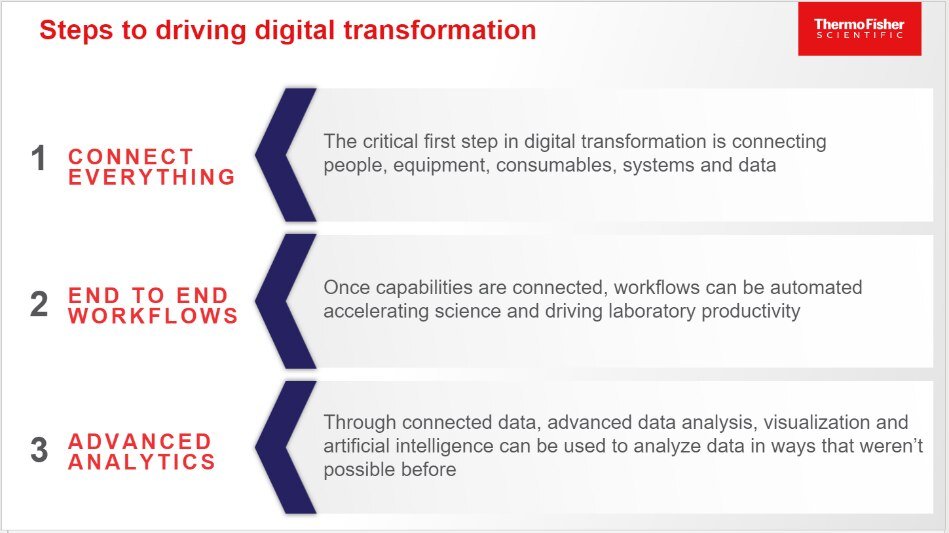Automated Science to Create the Lab of the Future
13 May 2021 | Thursday | Analysis | By Sarah Yesford | ThermoFisher Scientific

During the first webinar of the series, Ian Yates, Director of Enterprise Science and Innovation Partnerships at Thermo Fisher Scientific, shared a compelling perspective on automated science and the lab of the future. The webinar covered how digital solutions and lab automation are paving the way for innovation in the connected laboratory. Yates explained how technology-driven strategies can promote success and how automated science is a key driving factor.
Drivers for automated science
We are seeing scientific disruption in three main areas including the scientific terrain, digital disruption with new technologies, and the economics of the laboratory looking for ways to increase efficiency. Underlying this, data is becoming one of the laboratory’s most valuable assets. Those embracing digital transformation and adopting technologies are better at driving productivity and controlling cost.
Steps to driving digital transformation
Yates presented two lenses to consider when driving digital transformation: lab centric and data centric. The lab centric considerations include human experience, workflow, layout, and robotics. The data centric considerations include end-to-end data management, digital connectivity, advanced analytics, and AI. When asked how laboratories should begin an automated science or digital transformation journey, Yates suggested “It’s about understanding where one is starting the journey and mapping the current state of the digital or automation structure within the organization. Before rushing into transformation, know where you start and where you want to get to. Get a good understanding on the current situation and plan the roadmap to the future.”
Taking these lenses into account, there are three main steps to driving digital transformation:
Drivers for automated science
We are seeing scientific disruption in three main areas including the scientific terrain, digital disruption with new technologies, and the economics of the laboratory looking for ways to increase efficiency. Underlying this, data is becoming one of the laboratory’s most valuable assets. Those embracing digital transformation and adopting technologies are better at driving productivity and controlling cost.
Steps to driving digital transformation
Yates presented two lenses to consider when driving digital transformation: lab centric and data centric. The lab centric considerations include human experience, workflow, layout, and robotics. The data centric considerations include end-to-end data management, digital connectivity, advanced analytics, and AI. When asked how laboratories should begin an automated science or digital transformation journey, Yates suggested “It’s about understanding where one is starting the journey and mapping the current state of the digital or automation structure within the organization. Before rushing into transformation, know where you start and where you want to get to. Get a good understanding on the current situation and plan the roadmap to the future.”
Taking these lenses into account, there are three main steps to driving digital transformation:
Most Read
- How Health Systems Are Reshaping Drug Adoption, Partner Models, and Market Access in 2026
- Top 25 Biotech Innovations Redefining Health And Planet In 2025
- The New AI Gold Rush: Western Pharma’s Billion-Dollar Bet on Chinese Biotech
- Top 25 Biotech & Biopharma Leaders in Sustainable Innovation, 2025
- China’s Biopharma Dealmaking Surges in H1 2025, Driven by Record Licensing and Oncology Focus
- Chikungunya in China: How a “Forgotten” Arbovirus Found the Perfect Storm
- How Innovation Gaps in Biopharma Raise New Safety Concerns
- Smart Implants and the Future of Musculoskeletal Injury Treatment
- How Ethical Gaps in Psychiatry Could Undermine Biopharma Progress
- The Evolving Landscape of Women’s Health Innovation in the Asia-Pacific
- Using NLP-Driven Decision Support in Emergency Health Assistance
- Taiwan Steps Into the Global Spotlight With a New Cancer Therapy
- The Role of Unique Device Identification (UDI) in Tracing Medical Device Safety
- The Importance of a Patient’s Mental Health During Clinical Trials
Bio Jobs
- The State of Biotech and Life Science Jobs in Asia Pacific – 2025
- Avantor’s New CEO Ligner Aims to Unlock Global Potential and Deliver Shareholder Value
- AstraZeneca Commits $50 Billion to U.S. Expansion by 2030 in Biggest-Ever Global Investment
- Thermo Fisher, SAMRC, and South Africa’s Department of Science and Innovation Launch CATIR to Nurture Next-Gen Scientists
- Cube Biotech Appoints Former Sartorius CEO Dr. Joachim Kreuzburg to Board of Directors
- FDA’s AI Transition Marks a Turning Point in Drug Review: Industry Faces Pressure to Adapt Amid 20% Workforce Cut
- WuXi XDC Completes Mechanical Build of Singapore Bioconjugate Manufacturing Hub
News
Editor Picks











